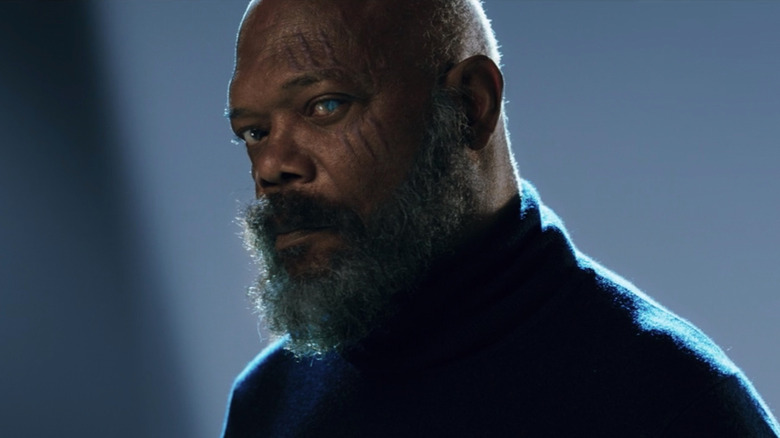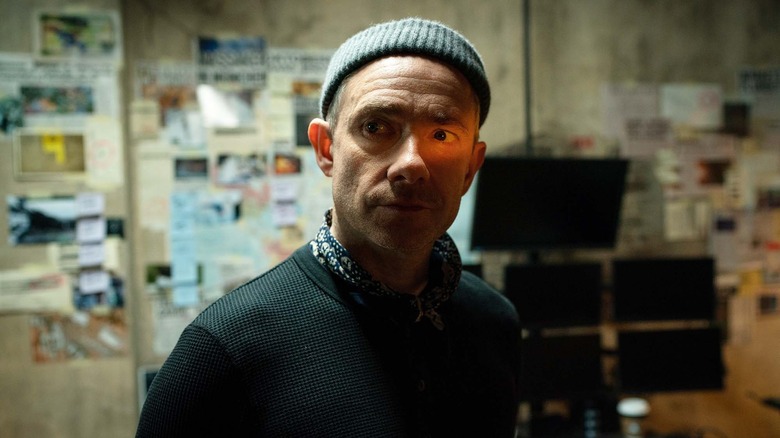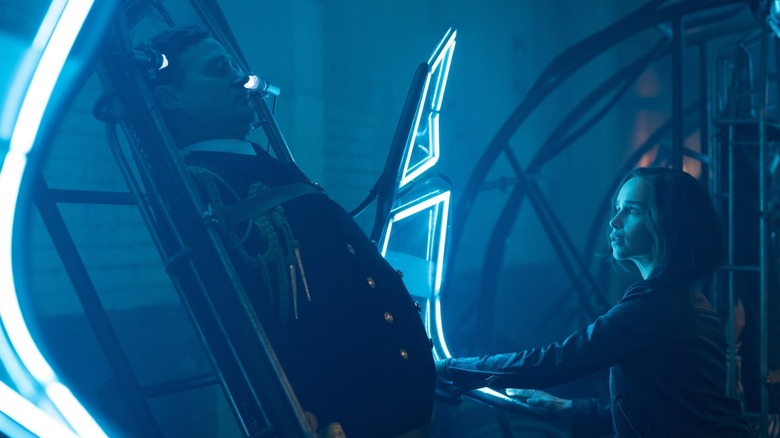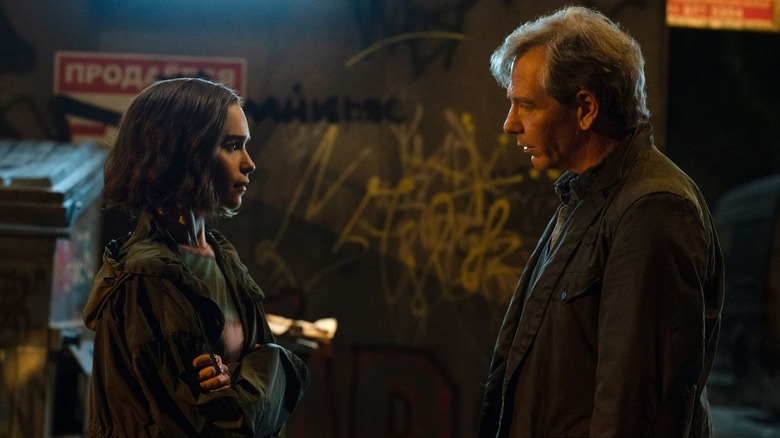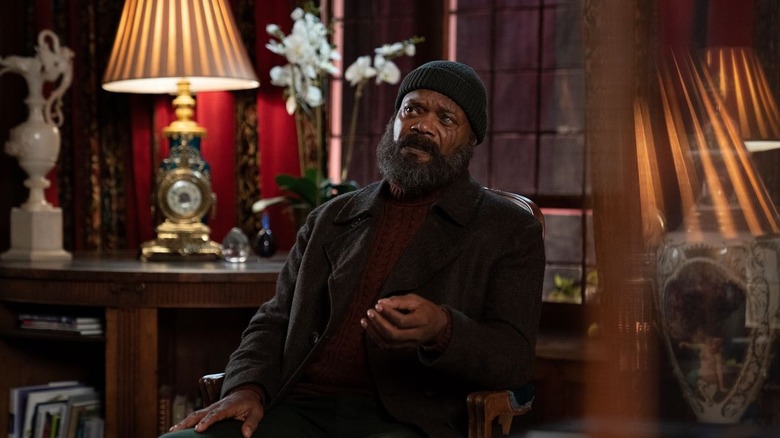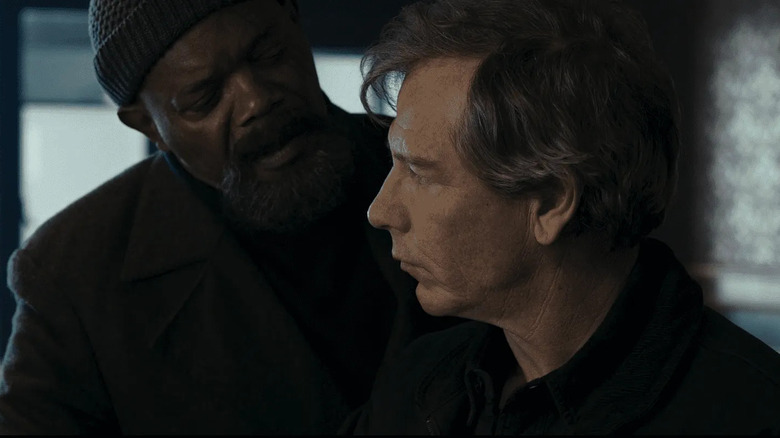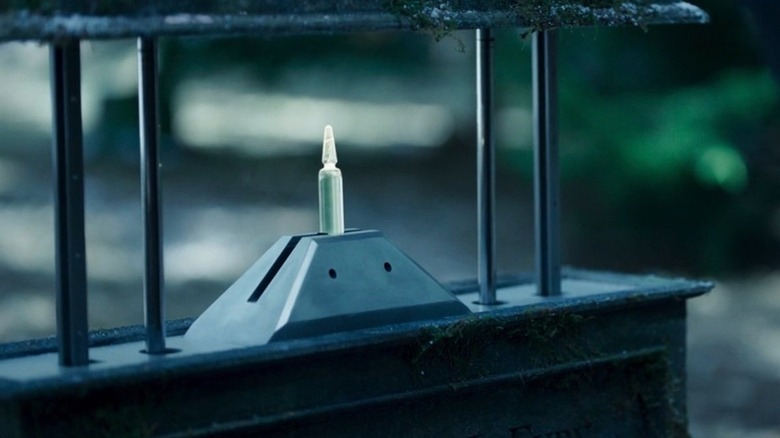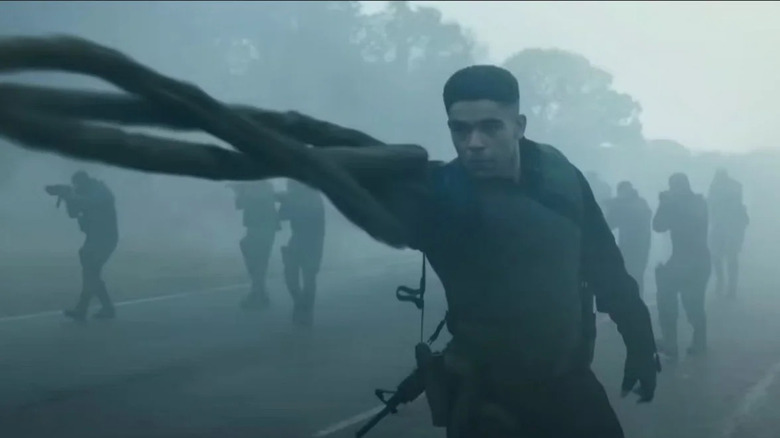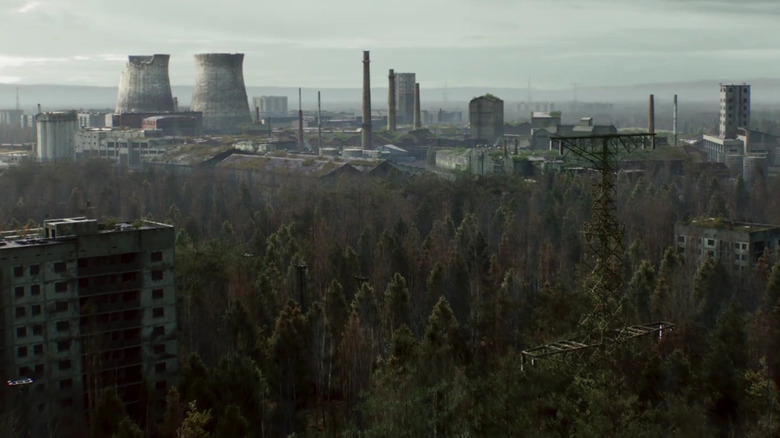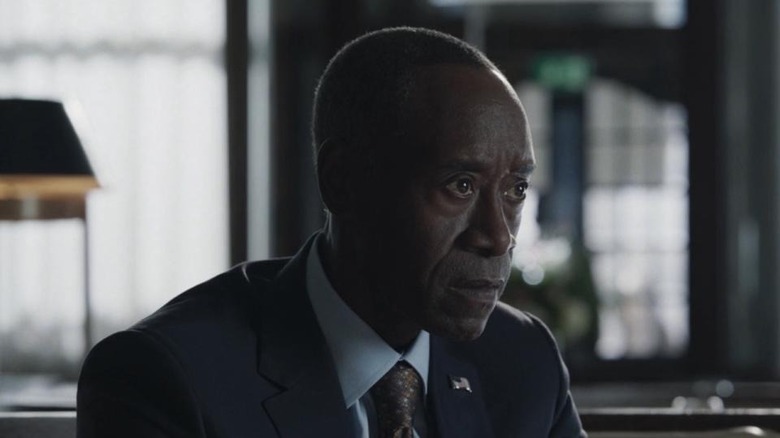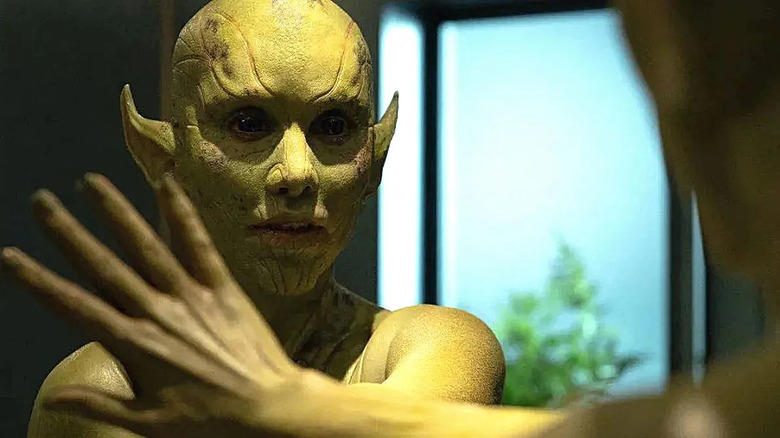The Most Confusing Moments In Secret Invasion Explained
Contains spoilers for Season 1 of "Secret Invasion"
With its central story revolving around shape-shifting aliens, Marvel Studios' latest TV series, "Secret Invasion," was always going to be purposely perplexing. The show was advertised as a spy thriller in the vein of "Captain America: The Winter Soldier," but with the MCU's world expanded to include outer space, and with the ability to change one's identity stemming from biology rather than technology. Both critics and fans agree it didn't quite live up to that comparison. "Secret Invasion" should have been full of high-wire tension and emotional twists, but the Nick Fury vehicle was unexpectedly straightforward, predictable, and at times frankly underwhelming. The most prominent fan theory came to pass, and there were few surprises otherwise.
But that doesn't mean "Secret Invasion" didn't intentionally (and perhaps, on occasion, unintentionally) misdirect and mislead us. Though everyone saw the Rhodey reveal, Super Skrulls, and G'iah's fake death coming from a mile away, other developments left fans with lingering questions instead of satisfying answers. Often (but not always) the reason wasn't the complexity of the espionage narrative, but underbaked plot points and character development. In short, even if the main storyline was almost shockingly easy to follow, some things in "Secret Invasion" Season 1 still require further explanation.
Skrulls versus Skrulls
Episode 1 of "Secret Invasion" opens with Everett Ross (Martin Freeman) meeting with a conspiratorially-minded Prescod (Richard Dormer), who's desperate to make his case that Skrulls have covertly invaded the planet and plan to instigate a war between the United States and Russia. His proof is that the random terrorist attacks that have occurred as of late are actually a little too random. At first, Ross seems skeptical, but then he assassinates Prescod out of nowhere and makes a run for it, with Maria Hill (Cobie Smulders) hot on his tail. So is a mysterious Russian-speaking man who chases Ross to the roof of a building from which he jumps and falls, severely injuring himself.
Hill and the mystery Russian convene over a pancaked Ross. "It's me," the man says, revealing himself to be Talos (Ben Mendelsohn). "What are you doing here," Hill asks, gun pointed. "I'm chasing him," Talos responds just as Ross turns into a Skrull and dies. "He was one of you," she says. "No," Talos corrects her. "He's one of them." This is our first hint that there are serious divisions with the secret Skrull society that exists on Earth, but audiences — especially casual viewers who aren't familiar with Skrulls from the comics or "Captain Marvel" — may have been confused by the distinction Talos was making in this cold open. In retrospect, poor Prescod was right about everything.
The pods
In the series premiere and many more times throughout "Secret Invasion," Skrulls capture humans and restrain them in a suspended state of consciousness inside what can best be described as open pods. These contraptions keep them upright and connected to computer-like devices that hack into their brains. The insurgent Skrull leader Gravik (Kingsley Ben-Adir) tells one of his followers, Brogan, to take the face and mind of their most recent victim. But exactly how Skrulls assume their human identities might confuse some viewers, mostly because there isn't just one way for them to do it.
Elsewhere in "Secret Invasion," we see Talos take the shape of a woman on a train. Gravik transforms into Nick Fury (Samuel L. Jackson), right in front of Fury's eyes, to frame him for the murder of Maria Hill. And in the season finale, he tells Fury (or so we think) that his human appearance is that of the first person he was ever made to kill. Similarly, Varra (Charlayne Woodard) adopts the appearance of a terminally ill woman she met, Priscilla. Once a person's dead, a Skrull can, figuratively speaking, wear their skin. Skrulls can do the same with any living humans kept in the pods, but they can also access their memories. The use of deceased and captive humans has more to do with security and practicality than biological processes. Doubles would compromise their cover and invite questions.
G'iah's turn
Throughout the first episode, G'iah (Emilia Clarke) serves as Gravik's right-hand woman. She's both a liaison to refugees making their way to New Skrullos and an agent in the field whenever Gravik needs someone he can trust. In the midst of the Unity Day bomb plot, Talos runs into G'iah and realizes she is his estranged daughter. He reveals that her mother is dead and implores her to give him the explosives, but she tells Talos that he can't protect anybody, and we're left with the impression that she's chosen to side with Gravik. Minutes later, however, she shows up to pass information along to Talos, Fury, and Hill.
Although she marks the backpacks with infrared spray, as promised, she also appears to participate in the bombing, which kills 2,000 civilians. Viewers might be of two minds about G'iah's allegiance after the first episode, and they might still wonder about her motivations after Episode 2, but Episode 3 makes it crystal clear that she's cooperating with Fury and her dad. Gravik arranges for his closest confidants to stage a missile launch, which outs G'iah as the traitor within his ranks when she stops it. However, when exactly G'iah turned, or whether she was always a double agent, is tougher to figure out. From her bitterness toward her dad, even as she's conspiring with him, we can tell that she's disappointed in his blind faith in humans — but is more disillusioned with Gravik's propensity for violence.
Fury past his prime
"Secret Invasion" repeatedly reminds audiences that Nick Fury isn't the man he used to be. Shortly after he returns to Earth, he's fired from official spy work and falls outside of the good graces of his longtime friend and ally Talos. Though Fury assures Rhodey (Don Cheadle) that even when he's out, he's in, the spy and special projects director is an island unto himself for most of the series. Another spy, Sonya Falsworth (Olivia Colman), has M16 kidnap Fury and bring him to her well-appointed flat. He plants a bug on her owl sculpture, which she covers up with an eyepatch.
Falsworth warns Fury that he's lost a step and would be a liability rather than an asset in her efforts to uncover Skrull activity. As evidence, she points out that it wasn't very hard for her men to apprehend him. He suggests that maybe he was trying to get caught. In Episode 6, he claims to have come back to Earth because he knew he was responsible for Gravik's ill-fated revolution. Did Fury want Falsworth to capture him? Was he playing a three-dimensional chess match against Gravik the whole time? The answer is probably yes to the first question, and "not quite" to the second one. Without the Avengers or the trust of his own government, Fury needs Falsworth's intel and help. In the end, they outsmart Gravik, but not before thousands of innocents, Maria Hill, and Talos have been lost.
The Blip
"Avengers: Infinity War" and "Avengers: Endgame" changed the MCU in ways that every Marvel movie and TV series since has had to contend with, "Secret Invasion" included. Just as often as characters tell Nick Fury he's past his prime, they lament that the Blip changed him. After he returned from oblivion, he practically exiled himself to his SABER space station. Though the show mentions the Blip and how it affected Fury on multiple occasions, it only mentions in passing how Thanos' snap affected the Skrulls.
Talos confesses that a million Skrulls currently live on Earth. Fury assumed the number was in the hundreds. Talos explains that when his people could no longer hold off the Kree, they answered his call, which he made because his host had "disappeared." In other words, the majority of the Skrulls emigrated during the period when half the population of Earth vanished. Presumably, this would have been a convenient time to assimilate and infiltrate seats of power.
In the finale, G'iah frees the heads of state and media personalities who are being kept prisoner, but we don't know if Skrulls had been impersonating them since before, during, or after the Blip. If the Skrulls had assumed the identities of high-profile Blip victims, they would need to round those key people up immediately upon re-materializing. There's also the fact that the Blip would have halved the Skrull population too, meaning that half a million shapeshifters would have conspicuously reappeared somewhere.
The Harvest
In Episode 2, we learn that Gravik is after something called the Harvest, which is more important to him than any of the false flag attacks he's staging to pit humans against each other. As it turns out, it's the DNA of the Avengers and their associates, collected after the Battle of Earth in "Avengers: Endgame." Gravik wants the genetic codes of the superheroes so that he can use his Super Skrull machine to give himself and every other Skrull the collective powers of almost every character we've seen in the MCU so far. He (along with G'iah) has already absorbed the effects of Extremis, as well as the abilities of Groot, a Frost Beast, and Thanos' henchman Cull Obsidian.
Fury takes Falsworth to a headstone with his name on it, where he's hidden a vial (it's implied there are others like this across the globe). When he has G'iah take the vial to Gravik as a bargaining chip to stop World War III, the Skrull leader scans it and sees that it's authentically the DNA of everyone from Captain America to Thanos. He uses his Super Skrull machine on himself, but instead inadvertently makes G'iah exponentially superpowered, and she kills him.
How Fury got and kept these samples is under-explained. For example, "Ant-Man and the Wasp" villain Ghost's DNA is contained in the vial, but she wasn't at the Battle of Earth. And why is all the DNA mixed into one little glass container?
Gravik's death
Every MCU property has a final battle, and some are better than others. The one in "Secret Invasion" might not be the biggest or best — it's between just two characters who we've only just met — but it involves the superpowers of many more MCU characters by way of Gravik and G'iah's Super Skrull status. That begs the question: if these two souped-up shapeshifters are equally matched, how does one manage to kill the other?
By the finale, we've already seen Gravik heal his hand when Talos stabs it and his face when Nick Fury shoots it. We know he's hard to take down. But G'iah makes pretty short work of him. After Gravik bulks up, G'iah — initially disguised as Nick Fury — stops his punch then launches him hundreds of feet out of the building. The two engage in hand-to-hand combat, switching superpowers as easily as if they were weapons.
Gravik seems to prefer the abilities of Groot, Korg, and Ebony Maw; G'iah transforms one of her arms into Drax's, but it's Mantis' empathic talents that allow her to put Gravik to sleep. He falls far to the ground beneath them, temporarily out of commission. But when he taunts her for being weak like her father, she uses Carol Danvers' energy blast to finish him off. It's worth pointing out that G'iah prevails thanks to the superpowers of female heroes like Captain Marvel and Mantis, and also appears to phase-shift like Ghost.
What about the radiation?
This is a potential plot hole that the show doesn't really address — at best, a single word is doing a lot of work to make it all make sense. The Skrulls are immune to radiation, so they've turned a former Russian nuclear test site into a community known as New Skrullos. G'iah explains that refugees are welcome to stay within its borders, while Gravik's soldiers can move about in the outside world. The high levels of radiation are a layer of protection for the Skrulls, as humans can't withstand exposure for long. That's why Gravik tells Fury to bring iodide to the compound, and it's why G'iah pretends to cough when she's disguised as Fury after Gravik's tossed the iodide away.
However, the Skrulls are also keeping humans in pods within New Skrullos, as we learn when Fury correctly guesses that Gravik plans to sacrifice some of his own people, plus their high value captives, in order to start the war he wants. But when G'iah releases Everett Ross, Rhodey, the Prime Minister of the United Kingdom, and others from their bondage, they seem fine. Wouldn't years' worth of lingering radioactivity have affected them, even in their dormant state? It's possible the Skrulls accounted for this and are pumping them full of iodide, but more likely, this is a narrative oversight.
Skrull Rhodey
The possibility that some of our favorite MCU characters could actually be Skrulls was a fun prospect going into "Secret Invasion." Before the premiere, nearly everybody's best guess was that James Rhodes had been a secret Skrull for some length of time. The show dropped hints throughout: Rhodey calls Fury by his first name during their contentious Episode 2 meeting, and Cheadle plays Skrull Rhodey's personality much more aggressively. The final confirmation is hearing his voice on the phone with Varra acting as an intermediary for Gravik. That Rhodey isn't really Rhodey isn't much of a twist; by the time he takes a bullet and turns green, the audience is already 100% sure he's an alien. But how long Rhodey hasn't been Rhodey is another story.
When G'iah unshackles the humans, Rhodey nearly falls over. She tells him he's been held hostage "a long time." What's a long time? A year? Five? Since before the Blip? The only clue we get is that Rhodey's wearing a hospital gown. He was wearing one after he was injured in the climactic battle of "Captain America: Civil War," which takes place nine years in the MCU's past. We can't be sure this visual reference is meant to date Rhodey's capture to this moment, but if that is when he was replaced by a Skrull, that would mean that the War Machine-slash-Iron Patriot we see having heroic and emotional moments with the Avengers during the rest of the Infinity Saga was an imposter.
What now?
Despite its connection to "Captain Marvel" and the rest of the MCU, "Secret Invasion" was curiously self-contained. There were no gimmicky cameos and no post-credits scenes. But an epilogue of sorts lets audiences know that just because G'iah and Fury have defeated Gravik, they haven't solved the problem at the heart of the show, which will most likely affect the MCU going forward.
G'iah tells Gravik that it's easier to save seven billion people's lives than it is to change their hearts and minds. Humans have now seen shapeshifting aliens on the news, and President Ritson (Dermot Mulroney) has confirmed that Skrulls were responsible for recent terrorist attacks. In response to what Fury calls the president's "hateful speech," panicked vigilantes begin going after anyone they suspect of being a Skrull. This appears to include the British Prime Minister and the host of a cable news show, both of whom were Skrulls at one point.
Whether the vigilantes attack the Skrull versions or the real humans is left ambiguous, as is how the enraged public gets credible information about potential Skrulls so quickly. Interestingly, President Ritson's bill doesn't just target Skrulls but any off-world species, which would include New Asgard. But surely the late Gravik will get his way, too, as humans are also indiscriminately killing each other out of paranoia. With Sonya Falsworth and new Skrulls leader G'iah now forming an alliance, it remains to be seen how the super spy and the Super Skrull resolve this intergalactic political drama.
